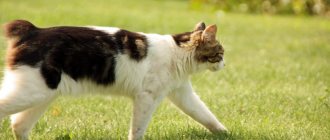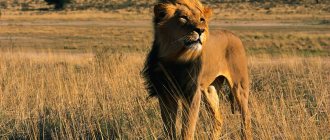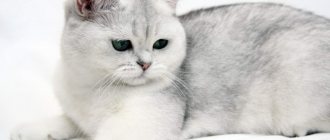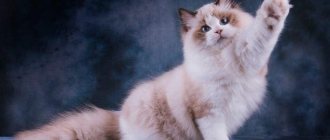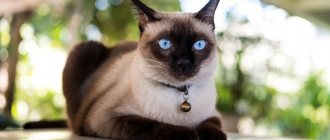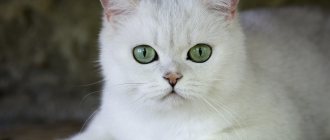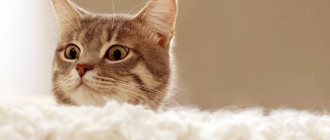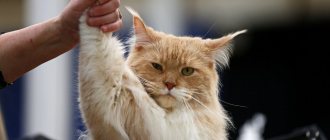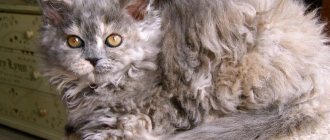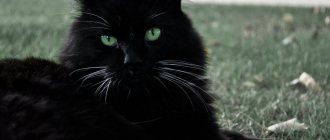The history of cats with tufted ears
Almost every long-haired cat has ear tufts . As they grow older, the tassels disappear. There are several officially recognized breeds for which tassels are standard.
Scientists still cannot determine what these funny tassels on the ears are for - just for decoration or have any functional significance.
However, three theories are known :
- Brushes work as sound amplifiers and help cats amplify weak sounds and convey the source of noise with high accuracy. Thanks to this “accessory,” the animals became professional hunters, able to hear the faint rustling of small animals under the snow. However, the theory was smashed to smithereens several times, since the hairs are absolutely not connected with the senses.
- A tuft of hair on the ears serves as a kind of beacon , thanks to which cats recognize each other at a great distance. For example, the lynx has excellent eyesight, and its tassels help it spot its relatives from afar, even in the dark.
- The brushes determine the age of the cat - the longer and darker the hairs, the older the animal. But even in an adult lynx, the tassels can have a light shade, so the theory, in fact, has no connection with reality.
Many breeders are interested in the question: when did the first cat with tassels on its ears appear? All recognized modern breeds have their own history of origin, but officially the oldest tasseled breed is considered to be the Norwegian Forest Cat . Scientists admit that it was she who became the ancestor of Maine Coons.
However, illustrations from the era of ancient Scandinavian culture indicate that Norse cats accompanied the Vikings until the 16th century. In some legends, the god Thor traveled with a "fluffy forest beauty", whose description resembles a modern Norwegian cat. If you believe the Scandinavian sagas, the first representative of cats with tassels was the beautiful Norwegian.
Purchasing kittens
Buying a bobcat is not difficult. There are nurseries in Russia where more than one generation of domesticated animals produces kittens suitable for domestication.
The price for a cat with wild roots starts at around 400,000 rubles. However, keep in mind that purchase costs are the tip of the iceberg. Veterinary support for wild species and their maintenance can sometimes exceed the cost of the kitten itself several times over the course of its entire life.
The most authoritative cattery in the CIS Luxury cat from Ukraine. The nursery specializes in wild cats and has been successfully operating since 2002. The breeding team has its own veterinarian and cat adaptation specialist, whom you can safely trust for primary socialization.
Cat breeds similar to lynx
The group of cats with tassels includes several breeds . Even the Neva Masquerade can acquire similar decoration.
Felinologists are confident that this is how the genes of our ancestors manifest themselves. The trait is not inherited, but appears randomly, so masquerade cats are not included in this group.
Caracal
Caracal is an oriental beauty with a wild and affectionate disposition . A mysterious, spectacular, graceful cat with a charming look will not leave anyone indifferent.
Most of the animals live in the wild . Domesticated individuals are rarely found.
This is an ancient species of cats living in Asia Minor and Central Asia , in the steppes and deserts of Africa, and in the Middle East. It is less common in Kyrgyzstan, Turkmenistan, and Uzbekistan; about 100 individuals live in the regions of Dagestan.
The name of the breed comes from the Turkic “kara kylak” , which in translation sounds like “black ear”. The back of the ears and tassels are painted black. The black border also runs along the inner edge of the ear.
Caracal is a cat breed similar to a lynx, distinguished by its large size : height at the withers 45-50 cm in height, body length 80 cm, tail length 30 cm. The body is strong, muscular, proportional, the paws are strong and long, covered with short, hard hair. The muzzle is elongated, wedge-shaped, the eyes are large, expressive, the ears are long, decorated with black tassels. Life expectancy is 15-18 years.
The wild caracal is a ferocious and unapproachable hunter, lightning fast, stealthy and strong. The domestic caracal is an affectionate and gentle animal, a friend and family pet . An important condition for successful socialization is education with love and respect, without physical punishment.
Caracals have excellent memory and developed intelligence . Cats love to go for walks, spend time with people, and be the center of attention. The representative of the breed is territorial, so stray dogs and cats are not allowed into a private home. The caracal gets along well with other pets, except birds and rodents.
Caracals have excellent health and rarely get sick , living to a ripe old age.
Caraquet
The caraquet is a domestic lynx cat similar to the wild caracal . American breeders tried to cross a domestic caracal with an Abyssinian cat. The experiment was a success. This is how the first hybrids of the second generation were obtained.
The second birth of the Carakets happened in the Russian city of Ivanovo. Breeder Irina Nazarova was inspired by the idea of breeding small wild cats. The crossing involved a young croak and a domestic cat.
Subsequently, representatives of the following breeds were used for breeding: Serengeti, Egyptian Mau, Abyssinian, and Oriental. As a result, the new breed developed distinctive features - large ears, long muzzles, excellent health and fertility.
The appearance of caraquets is colorful - they are quite large animals (9-12 kg) with strong long limbs , a wide nose, large eyes and huge black tufts on the ears. The color is uniform brown-red on the back and sides. A second generation of caracats is planned by crossing with Abyssinians in order to preserve the warm color and ticking.
Cats are completely devoid of aggression and are very sociable.
Important! Caracats cannot be declawed. They are great at retracting them, like many hybrids, so they don’t scratch or damage furniture.
Caracats inherit immunity from caracals, so they do not get sick and are not susceptible to genetic pathologies.
Maine Coon
The Maine Coon is a beloved breed native to Maine, USA. The cats are considered descendants of domestic shorthair cats crossed with Scandinavian cats . Felinologists trace a connection with the Norwegian forest cat.
The ancestral origin of the Maine Coon is unknown and is based on assumptions and legends :
- The breed appeared after the mating of a male cat and a female raccoon . As evidence, they cite the color of the tail, similar to the tail of a raccoon.
- The cats originally belonged to Marie Antoinette and were illegally imported into the United States.
- Maine Coons were created by crossing a North American lynx with a regular cat. The theory is confirmed by the presence of tufts on the ears, like a lynx.
Maine Coon is a cat with ears like a lynx, the breed is extremely large . Males weigh 6-10 kg, females 4-7 kg. The height is 25-41 cm, and the length reaches 120 cm, including the tail - 30-36 cm in length.
The body is strong, muscular, limbs are strong . The body is rectangular. Representatives of the breed mature slowly and reach their potential size by 3-5 years.
Maine Coons are curious by nature, sociable, but not annoying , and do not require special attention from the owner. Cats love to play with puzzle toys, look out the window, don’t mind walking on a leash, and are ready to accompany their owner on trips.
Cats adapt to any type of home , are not afraid of heat or cold, and are friends with dogs and cats.
Life expectancy is 9-15 years with proper care and a balanced diet.
Maine Coons have strong immune systems, but are predisposed to :
- hypertrophic cardiomyopathy;
- hip dysplasia;
- polycystic kidney disease.
Interesting. Maine Coons are silent and rarely meow. They usually “chirp” in high tones or emit melodic trills in a thin voice.
Pixiebob
The Pixie-Bob breed was created by an accidental connection between a cat named Pixie and a wild cat in 1985. The kittens were born tailless, which served as the starting point for the development of the breed. The breed received official recognition by the International Cat Association in 1994, and in 2005 by the American Cat Fanciers Association.
Adult cats are large, reaching 6-8 kg, females - 5-6 kg . Pixiebob is a kind, smart and playful animal that has absorbed the best qualities of cats. These cats are tireless participants in games, faithful travel companions, faithful friends and full members of the family.
The physique is massive, the chest is pronounced, the legs are short . The muzzle is wedge-shaped, the ears are of medium length. The coat pattern is striped. Life expectancy is 15-17 years.
Pixie-bob is an interesting breed of cat, like a lynx, which is distinguished by high intelligence and patience . These are soft and kind cats, adventurers by nature. They love to watch their owners' daily household activities - cooking, washing, cleaning. Pixiebobs normally perceive changes in situation and environment, are excellent at navigating the terrain, and have developed hunting instincts.
Representatives of the breed are generally healthy and not prone to genetic pathologies , despite the fixed short-tailed gene. Cats tend to be overweight, so they should not be overfed.
Interesting things on the site:
13 Largest Cat Breeds in the World
A cat like a leopard - what kind of breed is it?
Norwegian Forest Cat
It is not known exactly how the Norwegian forest cat appeared : either the Scandinavian goddess Freya cut through the clouds in a chariot drawn by six cats, or the animals appeared as a result of meetings between the Vikings and the Turks. If you believe the second theory, then the ancestor of the beautiful “Norwegian” should have been an Angora cat. There is another variant of origin - from a Siberian cat. In any case, the breed is ancient, indigenous, and developed in natural Scandinavia.
The harsh climate forced the animals to acquire warm, thick and long fur coats with dense undercoat, which allows them to withstand rain, snow and wind.
In the 30s XX century a group of European breeders set about creating a full-fledged breed with characteristic features. We didn’t think about the name of the breed for a long time. In their homeland, cats are called “Norsk Skaukatt”. Several individuals from the Norwegian Cat Fanciers Club participated in the exhibition in Oslo. The animals were received well and given high scores.
At the beginning of World War II, the breeding program was suspended and, unfortunately, most of the population became extinct. It took 40 years for breeders to become interested in Norwegian cats again. The breed received official recognition in 1993.
The Norwegian Forest Cat has a large build, long hind legs, a developed chest and muscles , and long ears with tufts. Animals can climb trees and hunt. In addition, they lead the lifestyle of an ordinary cat - bask in the sun, chew grass on the lawn, play with children.
The Norwegian cat has a stable and balanced character and a sharp mind . They are ready to give affection and warmth to all family members; they love to sit on laps and lie next to the owner.
Life expectancy is 12-16 years. The breed has strong immunity, but is prone to genetic diseases :
- accumulation of glycogen IV;
- hypertrophic cardiomyopathy;
- retinal dysplasiaNo.
- polycystic kidney disease.
Interesting. In Norway, cats are called "skogkatts", which translates as "forest cat".
Chausie
Chausie or Hausie is an unusual breed, a cross between the wild jungle cat Felis Chaus and the Abyssinian cat .
Crossing with a wild cat determines the cost of the breed - from 10 thousand US dollars. The breed is classified into 4 stages F1-F4 . The higher the number, the higher the percentage of wild blood. Kittens of the F1 group are obtained directly from crossing a jungle cat and an Abyssinian, F4 are no different in size from ordinary cats and have the maximum level of socialization.
These animals are large in size . The weight of males reaches 7-10 kg, females - 7-9 kg, and body length - 1 m. There are three types of colors - black, silver (ticked), tabby. The tip of the tail is invariably black. Elongated ears are decorated with tassels. The body is strong and flexible, the animals skillfully climb trees and make amazing jumps.
Chausie is a temperamental cat that cannot stand loneliness and prefers the company of its owner . Cats marked F3 and F4 are more suitable for home keeping, but in any case, animals will feel more comfortable in a private home with the possibility of free walking.
Chausies have retained the hunter's instinct; they are not afraid of water and swim skillfully . Cats get along well with dogs and other cats, but birds and fish are potential victims for them.
Some individuals have difficulty establishing contact with children due to innate aggression. They will not allow familiar or brutal treatment and extend their claws for protection.
Chausies have excellent health, they rarely suffer from infectious diseases and are not predisposed to genetic ones.
Kurilian Bobtail
The Kurilian Bobtail is a rare breed of cat originally from the Kuril Islands. By default, the breed is considered Russian . Outside of Japan and the Russian Federation, the Kurilian Bobtail is rare.
There are two varieties of the breed - short-haired and long-haired. The shorthaired bobtail was first registered 200 years ago in the Kuril Islands. Long-haired cats appeared later.
A distinctive feature of the breed is a short tail 5-13 cm long . The physique is massive, the body is strong, inclined forward, the paws are proportionally developed, the neck is of medium length, the head is wedge-shaped, large eyes, medium-sized ears.
The Kurilian Bobtail is a breed that never gets boring. This is a playful, smart, kind animal . Many qualities that appeared as a result of natural selection have been preserved to this day thanks to strong genes. Cats skillfully fish, swim freely, hunt well, and have an inquisitive and free character. They are affectionate and loving, quickly becoming attached to people.
The Kurilian Bobtail has excellent health and rarely gets sick .
The gene responsible for the short tail does not cause genetic abnormalities. However, cats tend to be overweight, so it is important to control the quality and quantity of food.
Diet
The bobcat is capable of surviving for long periods of time without food, but will feed heavily when prey is abundant. During periods of reduced food supply, he often hunts larger animals.
The Red Lynx usually stalks its prey, but can also set up ambushes, followed by a short chase and a final jump.
The cat prefers mammals weighing from 0.68 to 5.67 kg.
The main prey of the animal depends on the region. In the eastern United States it is the Florida rabbit, and in the north it is the snowshoe hare. When these prey species exist together, as in New England, they are the Bobcat's primary food sources.
In the far south, they often replace rabbits and hares with cotton rats as the main food source. They ambush birds the size of an adult swan along with their chicks and eggs.
The bobcat is an opportunistic predator that, unlike the more specialized Canada Lynx, readily changes its choice of potential prey. The abundance of its main prey species is a major determinant of its overall diet. Although the male prefers rabbits and hares, he also hunts insects, chickens, geese and other birds, small rodents and deer. The choice of prey depends on the location and habitat, season and abundance of the food supply.
The bobcat hunts animals of different sizes and adjusts its hunting methods accordingly. With small animals such as rodents (including squirrels), birds, fish, including small sharks, insects, it feeds in areas with an abundance of potential prey, and is able to lie, sit, or stand and wait for them in ambush, or wander nearby . It then pounces on its prey, grabbing it with its sharp, retractable claws.
For larger animals such as geese, rabbits and hares, it emerges from cover and waits until the prey is within 6-10 m before charging.
Less commonly, the animal feeds on larger animals, such as young ungulates, other carnivorous species, such as fishing cats (mainly females), foxes, minks, martens, skunks, small dogs and domestic cats.
While larger species (cattle and horses) are not attacked, bobcats pose a threat to smaller ruminants (sheep, goats).
The Red Lynx is known to quietly kill deer, especially in winter when small prey are scarce or when ungulate populations become more abundant.
The vast majority of such prey are young, but nevertheless the animal is able to cope with a deer that weighs more than eight times it.
A bobcat often attacks a lying deer, grabbing it by the neck, biting its throat, base of the skull or chest. On rare occasions, the Red Lynx will kill an ungulate, eat some of the meat, and then bury the carcass under snow or leaves, often returning to it several times to finish eating.
The Red Lynx's competitors and enemies are foxes and coyotes.
Health and susceptibility to disease
On a walk
The lifespan of pixiebobs is about 12-15 years. They are in good health and in good physical shape.
Heredity is good, so diseases along this line are extremely rare. There have been cases of diseases of the genitourinary system, as well as heart disease. To prevent diseases, you need to be regularly examined by veterinarians, and when buying a kitten, find out about the diseases of the parents.
Breed defects
Description of appearance defects due to which an animal may receive fewer points:
- The belly is dark.
- The length and smoothness of the coat is inconsistent.
- Lack of distinct eyebrows and chin.
- Ears are not large enough or set too high.
- Distorted head shape, too flat forehead.
- Inconsistency in the bend of the legs.
- Not wide hips.
- The skin pouch on the abdomen is not pronounced.
- The back is too flat.
- The tail is either too small or too long.
Active and playful cats
. Vices that prevent you from obtaining a title:
- The color or pattern of the coat does not meet the standards.
- The presence of a wool collar.
- Irregular eye shape.
- Too thin build.
Disadvantages leading to disqualification:
- No tail.
- The tail is too small or full length.
- Presence of more than 7 toes on the paws.
Summarizing
Table. Comparison of cat breeds similar to lynxes
| Dimensions, weight | Cost of a kitten | Character | |
| Caracal | Weight up to 25 kilograms, at the withers up to half a meter. | From 600 thousand rubles to 1.5 million | Can be aggressive |
| Caraquet | Weight up to 15 kilograms, at the withers up to 40 centimeters. | From 500 thousand to 1.2 million rubles | An experimental breed in which breeders are trying to get rid of aggression |
| Maine Coon | Weight up to 15 kilograms, at the withers up to 35 centimeters. | 30-70 thousand rubles | Affectionate but capricious |
| Bobtail USA | Weight up to 9 kilograms, at the withers up to 30 centimeters. | 25-50 thousand rubles | Gentle, obedient |
| Norwegian forest | Weight up to 10 kilograms, at the withers up to 30 centimeters. | 25-50 thousand rubles | Independent, friendly |
| Pixie bob | Weight up to 8-9 kilograms, at the withers up to 25 centimeters. | 50-100 thousand rubles | Phlegmatic, calm, flexible |
A person who likes the appearance of a wild lynx may well have a miniature pet. There are several breeds of cats that are more or less similar to lynxes. Therefore, choose a pet that will please the eye, but not burden your wallet and everyday life.
Breeding
Mating with other breeds is not allowed. Americans do not like to sell these cats outside of their country, especially when it comes to breeding. Therefore, in Russia it is very difficult to select cats for mating.
The partner is selected in advance, after checking the pedigree and health. Both partners undergo examination at a veterinary hospital before mating. Be sure to have all the necessary vaccinations and get rid of parasites two weeks before mating.
A cat can meet a male cat from the age of 1 year, but must wait until after the second or third heat. It is important for a cat to be older and more experienced, then there is a greater chance of success.
Mating rules:
- On the second or third day of estrus, the cat is brought to the cat’s territory and left there for 3-5 days.
- It is better to give cats a separate room.
- Before the process, it is better to trim your pets' nails so that they do not injure each other.
Sterilization and castration
A rare breed for our country
It is believed that sterilization harms the health of pets and shortens their life, but this is not true. In fact, castrated animals live longer than others and become ill less often. They have no hormonal problems, a stronger psyche, they are more intellectually developed, and they communicate more easily with people. The likelihood of cancer is reduced. The animal's life becomes calmer and better.
Veterinarians tend to recommend castration of pets at the age of 7-9 months. At this age, the process of puberty has not yet completed, but the body is already sufficiently formed. It is better for a cat to be sterilized before or after the first discharge.
When the anesthesia wears off, the animal needs supervision. Do not feed the animal, give it a little to drink. If the animal tries to crawl into the wound, an Elizabethan collar will need to be worn. If the animal is cold, it needs to be wrapped and warmed. The seams need to be treated with brilliant green. If suspicious symptoms appear, you need to show the animal to a veterinarian.
What does it eat?
Lynx on the hunt
The lynx's favorite food is hares and squirrels. If she does not find her usual food, she can hunt artiodactyls: roe deer, young deer, musk deer. Will not disdain young wild boars. A gaping fox or raccoon dog will also attract the attention of a predator as prey. If you come across birds along the route: hazel grouse, black grouse, wood grouse, the lynx will not refuse delicious meat. In the absence of favorite game, the animal feeds on small rodents.
Interesting: Gravity and gravitation - interesting facts, description, photos and videos
A predator needs 3-4 kg of meat per day. If some of the prey remains uneaten, the lynx buries it to return later.
How long does he live?
Life expectancy of the common lynx and its feline counterparts in the wild:
- Euro-Asian – 20 years;
- Canadian lynx – 15 years;
- red lynx – 12 years;
- Pyrenean – 13 years.
Interesting: How did the Earth appear? Description, illustrations, video
If the animal is kept in captivity, life expectancy increases. Of course, this is influenced by the conditions of the animal’s keeping, nutrition, and the absence of danger. For example, the common and Canadian lynx can live up to 25 years. There is a known case when the life expectancy of a red lynx was 32 years.
Colors
The color of cats can change depending on the season and molting. May be brown or have a gray shade of spotted tabby, gray or inverted ticking. Sometimes the coloring is similar to a wild lynx, for example lighter in the head and belly area.
Detailed characteristics of the drawing:
The pads on the paws should be dark brown or black. The tip of the tail is dark brown. Dark stripes from eyes to cheeks. There is a light edging around the eyes. The forehead has a dark pattern in the shape of the letter “M”. The mustache is dark at the base to white at the ends. Spots of varying sizes may occur throughout the body, subdued by tagging, in different orders. The abdominal area is spotted.
Character and habits
Smart and well-mannered cats,
Piskibobs are trusting, gentle creatures. They consider the family in which they live to be their pack, become very attached, and love every member of the family. They need to be in the center of events, love attention and cannot live without communication. They are very bored when they are left alone at home, patiently waiting for their owners. They are very loyal.
Pixie-bob cats are playful, active and fun-loving. Capable of carrying toys in their teeth. They love to jump and climb trees. They always come when called.
They are very smart, think well, and are curious. They respond to human speech with meows, specific sounds just like servals.
They adapt to the life schedule of their owners. In the kitchen they behave in a balanced and calm manner, patiently waiting to be fed.
"Aborigines" from the Isle of Man
This is roughly the name given to the Manx cats that settled on the Isle of Man in the Irish Sea. How they got there is not known for certain, although there are many versions: from biblical to modern scientific.
Today there are 4 varieties of Manx. Depending on the length and shape of the tail, cats are divided into:
- Rampi (sacral). The tail is completely absent.
- Riser (growth). Instead of a tail, there is only a small protrusion on a couple of vertebrae. -9
- Stumpy (short). A small tail measuring 4-8 vertebrae.
- Longi (long). Quite a long tail, almost identical to the “classic” length.
- Rumpy
- Stumpy
- Riser
- Long
If we talk about character, animals are cheerful and energetic. They love active games, love to climb trees and have enviable jumping ability. The habits of cats are somewhat similar to dogs, in particular, this concerns learning various commands. Since Manx cats are very sociable, they are not recommended for people who are rarely at home.
Another distinctive feature of this breed is its excellent hunting qualities. Owners of such pets should be calm about the fact that prey in the form of mice, rats, moles and other garden and dacha “fauna” will be brought into the house. Manx cats will always find a common language with children, even when the baby is too persistent in showing his love and tormenting the cat with annoying caresses.
Captivity
Bobcats are well socialized, especially when adopted by humans at a young age.
For an adult animal, it is necessary to build a spacious enclosure outside; the animal tolerates the cold well, so a winter road is not required.
Places for your pet to hide and climb should be provided. It is better to put a hollow log at the bottom, sharpen the shelves and ladders.
The Red Lynx will only eat raw meat, poultry, and rabbit meat, and will definitely refuse dry food.
The pet needs attention and affection and full care, annual vaccination, regular deworming and treatment for external parasites.
Dimensions and weight
The color of cats can be different.
Pisky bob cats can be of different sizes. The average weight of an adult cat is 5-8 kg. But there are very large cats, reaching a weight of 12 kg. Cats, on the other hand, are smaller in size, weighing 3-5 kg.
The average height is 30-35 cm by 12 months, but it happens that pets grow to this size only by 4 years.
A smaller copy of the caracal – caracat
Zoologists set out to create a special breed of cat that would retain the external features of the caracal, but would have a softer disposition and smaller size. To accomplish this task, an Abyssinian domestic cat was chosen and crossed with a representative of the lynx. The first generation hybrid appeared only 7 years ago. The breed was named Caraquet.
These hybrid animals have retained the main characteristics of the caracal; they have a similar coat color and characteristic ear tufts. From their wild ancestor, the pets inherited strong immunity, a gastrointestinal tract capable of easily processing heavy food, and energy. But caracats have a more affectionate, friendly character. Work is still underway to improve this breed; the kittens are very expensive.
